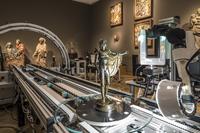Disasters are threatening historic cultural treasures. For the first time last week, Fraunhofer researchers automated 3D reconstruction of artifacts in the Frankfurt Liebieghaus Skulpturensammlung, making them accessible for eternity.
CultLab3D, the world-s unique 3D scanning facility for cultural artifacts, was in operation inside the Medieval Room of the Frankfurt Liebieghaus Skulpturensammlung from July 21th to 27th 2014. CultLab3D, developed by Fraunhofer IGD, is to revolutionize the needed 3D digitization of cultural artifacts. The artifacts, threatened by environmental influences and disasters, are secured in their current state of preservation and at the same time are made accessible to international research. So far, this process has been very expensive and time-consuming. With CultLab3D, the Fraunhofer researchers are relying on the industrialization and automation of the entire 3D digitization process of artifacts by means of state-of-the-art scan and illumination techniques. The mobile digitization laboratory thus allows for the millions of existing artifacts to be scanned and archived in an industrial, cost-effective and fast manner.
With their CultLab3D, the Fraunhofer researchers are digitizing genuine cultural artifacts for the first time in a fully automated way in Frankfurt. “In this test run, we gained a great number of very valuable insights”, says Martin Ritz of Fraunhofer IGD. “The properties of the different sculptures but also the conditions in the museum operation are providing us with some important impulses to further develop CultLab3D.” This is how the researchers managed, among other challenges, to apply the automated scanning process with industrial cameras to very dark and low-contrast objects as well. In the process, CultLab3D does not only capture geometry and texture of artifacts but also their optical material properties such as reflection and absorption behavior. This allows for a photo-realistic 3D illustration.
So far, 3D scans of art treasures have entailed laborious and cost-intensive manual labor for the most part. Due to the higher speed, the Fraunhofer researchers aim to reduce the cost of 3D scans tenfold to twentyfold. The outlook of being able to digitize entire collections in the future is very welcome to Prof. Dr. Vinzenz Brinkmann, head of the collection of antiques at the Liebieghaus Skulpturensammlung: “Whoever knows how we had to work before, will recognize the “miracle” of the scanning facility. Entirely new ways of scientific study will now open up to museums around the world.”
Further information:
http://s.fhg.de/Liebieghaus-Press-release
www.cultlab3d.eu
Fraunhofer IGD is the world-s leading institute for applied research in Visual Computing. Visual Computing is image- and model-based information technology and includes computer graphics, computer vision, as well as virtual and augmented reality.
In simple terms, the Fraunhofer researchers in Darmstadt, Rostock, Graz and Singapore are turning images into information and extracting information from images. In corporation with its partners, technical solutions and marketrelevant products are created.
Prototypes and integrated solutions are developed in accordance with customized requirements. In doing so, Fraunhofer IGD places users at the forefront, providing them with technical solutions to facilitate computer work and make it more efficient.
Owing to its numerous innovations, Fraunhofer IGD raises man-machine interaction to a new level. Man is able to work in a more result-oriented and effective way by means of the computer and visual-computing developments. Fraunhofer IGD has more than 200 employees.
The budget amounts over 17 million Euro.


You must be logged in to post a comment Login